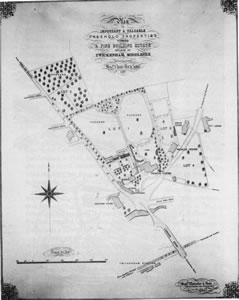Thomas Twining III
Noted scientific educationist and polymath
1806 - 1895

Fifth generation of Twinings in Twickenham
Thomas III was the fifth generation of the family to have been connected with Twickenham and he was, perhaps, the most notable member, with the possible exception of his cousin Elizabeth at Dial House.
In 1838 his father, Thomas II bought the property known as Perryn House, Twickenham, at the junction of the London and Whitton Roads. The family had been living in Europe and travelling widely. It was possibly during this time that Thomas came to the view that England had fallen behind Europe in technical education. As a result the rest of his life was devoted to the promotion of this cause.

Promotes technical and scientific educationIn Twickenham he established his Museum of Domestic and Sanitary Economy, to be known as The Twickenham Economic Museum. It was not Twickenham's first recorded museum - that honour goes to Alexander Pope's museum of mining and geology created in his grotto in 1739. Nor did it have anything to do with the history of the place - it was devoted to technical education, a subject which engaged Twining's devouring interest for much of his life.
The museum opened in July 1860 but, unhappily and although equipped with a fire engine, it burnt down in May 1871 and was not rebuilt.
However, the short-lived building was no more than a brief incident in a life devoted to the cause of technical and scientific education - a mission which he pursued with extraordinary energy for over 40 years - writing, publishing and lecturing. All this with his sight permanently impaired through exposure to snow glare from the age of 17, unable to move without crutches after an injury at 23 for the rest of his life and with his voice damaged by medical treatment.
Writing on 8 June 1878, Grant Duff, then living at York House, noted: Went over to see Mr Twining, an old gentleman who lives near us. Crossing the Alps as a boy he injured his eyes by the glare of the snow, and not very long afterwards, falling on the ice at Milan, became a cripple for life. He has devoted himself, nevertheless, to the economic bearings of science, has written a good deal, organised a scheme of lectures for the people, and had at one time accumulated a very remarkable museum, illustrating his favourite subject, much of which was, however, destroyed by fire.
Faraday's invalid chair
His own disability probably made him sympathetic to others with similar problems. He appears to have had an invalid chair made for Michael Faraday who in about 1845 had suffered a physical disability affecting the use of his legs. In 1895 this chair came into the hands of John Rudd Leeson, Twining's doctor and Charter Mayor of Twickenham in 1926. Leeson gave the chair to the Athenaeum in 1908.
Twining's daughter, Augusta (1852-1911), married August Christoph Rudolph de Wette (1845-1912) on 23 July 1872. They lived first in a part of the villa built by Baroness Howe adjacent to the site of Pope's Villa before moving, in 1884, to Hampton Court House. De Wette's father was described, in the record of the marriage at St Mary's, Twickenham, as Ludwig Wilhelm Martin Leberecht, Doctor of Medicine and Sanitary Commissioner from Bâle, Switzerland.
Further reading:
B L Pearce, Thomas Twining of Twickenham, Borough of Twickenham Local History Society Paper No61, 1988
R S Cobbett, Memorials of Twickenham, 1872
London Metropolitan Archives, Correspondence
Royal Society of Arts, Archive
Leslie Paton Collection, Local Studies Library, The London Borough of Richmond upon Thames




